Minestrone soup is the ultimate one-pot meal—wholesome, hearty, and bursting with fresh ingredients that come together in a rich, savory broth. Rooted in Italian tradition, this vegetable-packed soup has stood the test of time not only for its bold flavors but also for its flexibility. Whether you’re craving a comforting dinner or prepping healthy lunches for the week, this soup delivers on all fronts.
With every spoonful, you get a nourishing mix of fiber-rich beans, seasonal vegetables, and aromatic herbs simmered to perfection. It’s naturally vegetarian, easy to make vegan, and can be adapted to gluten-free diets by simply switching up the pasta or grains. No matter how you personalize it, minestrone soup brings comfort, nutrition, and rustic charm to the table.
In this comprehensive guide, you’ll learn how to build the perfect minestrone soup from the ground up—starting with essential ingredients and ending with pro tips for freezing leftovers and adding flavor-packed toppings. We’ll explore seasonal variations, protein-rich add-ins like quinoa, and common cooking mistakes to avoid.
Want to add even more flavor and texture to your next meal? Don’t miss our Dense Bean Salad, a perfect companion to a hot bowl of soup.
Whether you’re new to homemade soups or a seasoned cook, you’re just a few steps away from mastering a timeless recipe that never disappoints.
The Heart of Minestrone Soup
Minestrone Soup and Its Italian Roots
Minestrone soup is more than just a vegetable soup—it’s a centuries-old tradition that began in the humble kitchens of Italy. Originally crafted as a way to use up leftover vegetables, beans, and grains, this rustic dish has evolved into a beloved staple served in homes and trattorias across the globe.
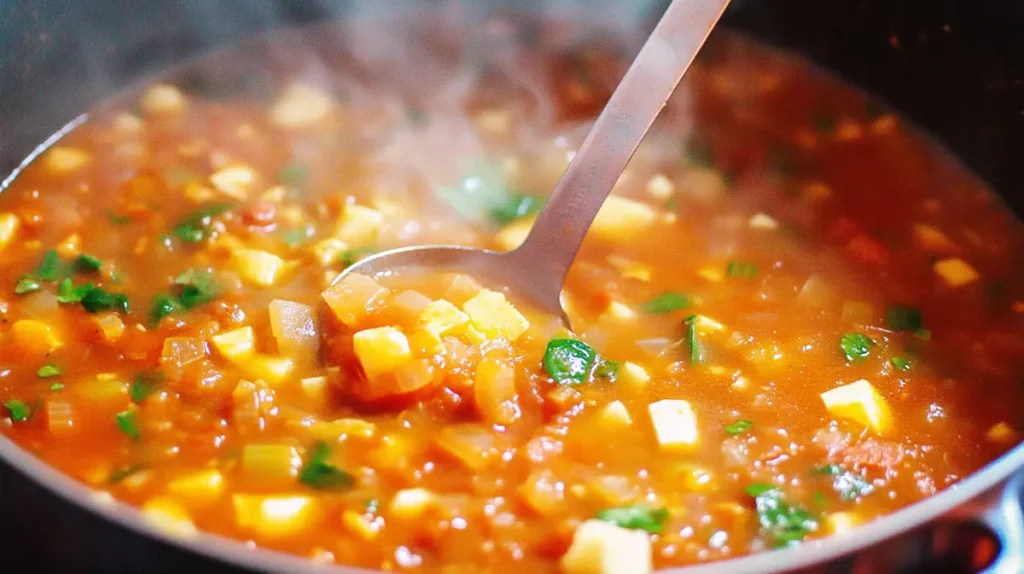
At its core, minestrone soup is a celebration of simplicity and abundance. There’s no single “authentic” version; instead, the recipe adapts to whatever’s fresh and in season. One family might simmer it with cabbage and potatoes in the winter, while another adds zucchini and green beans in the summer. This flexible, no-waste approach makes minestrone not only deeply rooted in Italian food culture, but also incredibly relevant for modern home cooks.
In Tuscany, it’s common to find minestrone thickened with day-old bread. In Liguria, it might be topped with a swirl of homemade pesto. And in Southern Italy, chili flakes or sausage bring the heat. No matter the region, one thing remains constant: minestrone soup is hearty, healthy, and made to be shared.
Why It’s Still a Staple in Modern Kitchens
In today’s fast-paced world, it’s rare to find a dish that checks all the boxes—delicious, affordable, healthy, and easy to prepare. Yet minestrone soup does exactly that. It’s rich in fiber, loaded with plant-based protein, and low in fat. Plus, it’s naturally vegan-friendly and can be made gluten-free without sacrificing flavor or texture.
Here’s why this timeless soup continues to win over new fans:
| Benefits of Minestrone Soup | Why It Matters |
|---|---|
| Full of fiber and vitamins | Supports digestion and immunity |
| Naturally plant-based | Ideal for vegetarians and vegans |
| Uses everyday ingredients | No hard-to-find components |
| Budget-friendly | Makes a large batch from inexpensive staples |
| Customizable for all seasons | Works with both fresh summer and winter produce |
Whether you’re trying to eat more vegetables, clean out your fridge, or prepare a week’s worth of lunches in one go, minestrone soup delivers in every way. It’s the definition of comfort food done right—without the guilt.
Key Ingredients in a Traditional Minestrone
What Goes Into a Classic Minestrone Soup?
Minestrone soup is built on simple, wholesome ingredients—yet the magic lies in how they’re layered. Each element adds flavor, texture, or nutrition, working together to create a deeply satisfying bowl. While recipes vary from region to region (and kitchen to kitchen), there’s a classic structure you’ll find in nearly every version.
Here are the key building blocks of a traditional minestrone soup:
| Ingredient Type | Examples | Purpose |
|---|---|---|
| Aromatics | Onion, garlic, celery, carrots | Flavor base (sofritto) |
| Vegetables | Zucchini, spinach, green beans, potatoes, cabbage | Texture, color, vitamins |
| Beans | Cannellini, kidney, or chickpeas | Protein, fiber, hearty texture |
| Tomatoes | Crushed, diced, or pureed | Adds acidity, umami, and color |
| Carbs | Ditalini, elbow pasta, rice, or quinoa | Makes it a complete meal |
| Liquid | Vegetable or chicken broth | Carries flavor, simmers ingredients |
| Herbs & Spices | Bay leaf, thyme, oregano, basil | Traditional Italian flavor |
| Finishers | Olive oil, lemon juice, or Parmesan rind | Depth and balance |
Whether you’re keeping it vegetarian or adding in protein, minestrone soup welcomes adaptation. You can easily substitute pasta with quinoa, toss in different beans, or adjust the veggies based on what’s in season or sitting in your fridge.
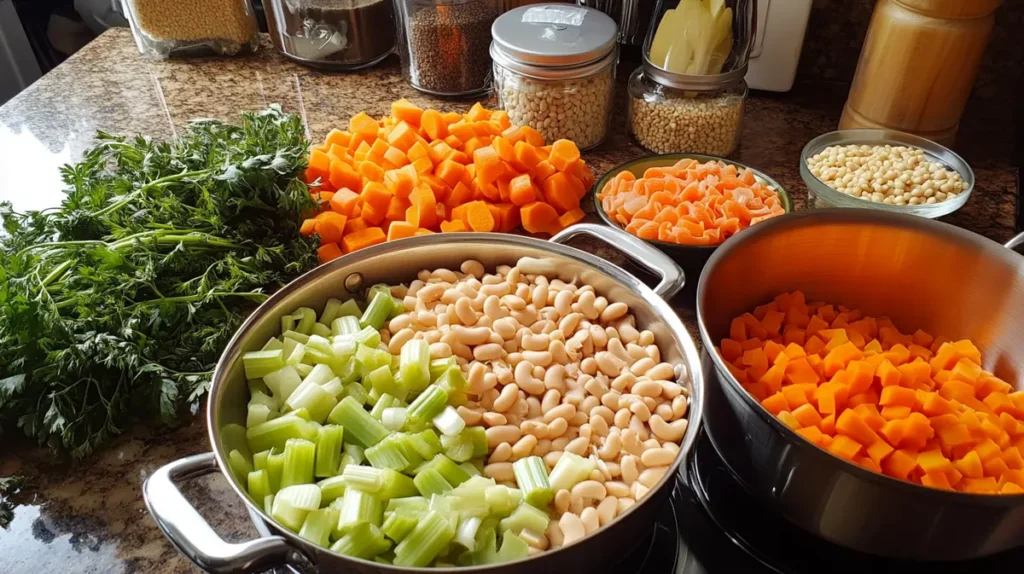
Why Ingredient Quality Matters
Fresh, seasonal ingredients make all the difference in minestrone soup. Using ripe tomatoes or farmstand zucchini in the summer will give you an entirely different flavor than a winter version made with sweet potatoes and kale. The beauty of minestrone is that it evolves with the seasons—no two batches have to be the same.
Quick Ingredient Tips:
- Choose low-sodium broth so you can control salt levels.
- Always rinse canned beans to reduce excess sodium and improve texture.
- If using pasta, cook it al dente directly in the soup—or separately to avoid sogginess in leftovers.
- Add tender greens like spinach or kale during the last 5 minutes of cooking.
The Secret Ingredients and Flavor Boosters
The Hidden Touches That Transform Your Minestrone Soup
Minestrone soup may be rooted in simplicity, but what separates a good pot from a great one often comes down to a few secret ingredients. These are the flavor boosters that don’t always appear in the basic recipe, but when added, they round out the dish with richness, umami, and a satisfying depth that keeps you going back for seconds.
From cheese rinds to bright finishes, here’s how to give your minestrone soup that wow factor.
1. Parmesan Rind: The Italian Chef’s Trick
Tossing in a Parmesan cheese rind during the simmering stage adds an incredible umami richness to minestrone soup without overpowering its vegetable-forward profile. It slowly releases nutty, salty notes that build layers of flavor as the soup cooks.
Tip: Remove the rind before serving. If you’re vegan, use a dash of nutritional yeast for a similar savory depth.
2. Pesto: A Swirl of Bold Herbal Flavor
Stirring in a spoonful of basil pesto just before serving is a game-changer. This herby addition enhances the soup with fresh garlic, nuts, olive oil, and Parmesan—all concentrated in one flavor-packed spoonful.
Pesto brings a bright, garlicky intensity that pairs beautifully with the hearty base of minestrone soup. For a dairy-free option, try vegan pesto made with cashews or walnuts.
3. Balsamic Vinegar or Lemon Juice: Acid Balancing
Soups that simmer for a long time sometimes taste flat. That’s where a splash of acid comes in. A tablespoon of balsamic vinegar or a squeeze of lemon juice added at the end of cooking lifts the flavor and balances the richness of beans and tomatoes.
This small step adds a brightness that transforms your minestrone soup from decent to dynamic.
4. Crushed Red Pepper Flakes: Subtle Heat
For those who like a little kick, a pinch of red pepper flakes goes a long way. Add it when sautéing your aromatics, or sprinkle some on top when serving. It gives minestrone soup a gentle warmth that lingers without overwhelming the dish.
Bonus Boosters to Experiment With
| Booster | Flavor Benefit | How to Use |
|---|---|---|
| Sun-dried Tomatoes | Intense, sweet-savory umami | Dice and stir into the soup base |
| Garlic Oil Drizzle | Rich, aromatic finish | Drizzle over the top before serving |
| Fresh Herbs | Bright, fresh note | Sprinkle parsley or basil right before serving |
| White Wine | Acid and complexity | Deglaze pot after sautéing vegetables |
These subtle tweaks require minimal effort but yield maximum reward, giving your homemade minestrone soup the complexity usually found in high-end bistros.
Print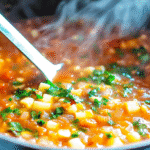
Hearty Vegan Minestrone Soup with Quinoa – A Nourishing Italian Classic Reinvented
- Total Time: 45 mins
- Yield: 6 servings 1x
- Diet: Gluten Free
Description
This hearty vegan minestrone soup is a wholesome twist on the Italian classic, packed with vegetables, protein-rich quinoa, and savory herbs. Perfect for chilly nights, this nourishing one-pot meal is gluten-free, oil-free (optional), and incredibly flavorful!
Ingredients
1 tbsp olive oil (or water for oil-free)
1 onion, diced
3 garlic cloves, minced
2 carrots, diced
2 celery stalks, diced
1 zucchini, diced
1 cup green beans, chopped
1 (14 oz) can diced tomatoes
4 cups vegetable broth (low-sodium if preferred)
1 (15 oz) can kidney beans, drained & rinsed
1 (15 oz) can white beans, drained & rinsed
½ cup quinoa, rinsed
2 tsp Italian seasoning
1 tsp dried basil
½ tsp smoked paprika (optional)
Salt & black pepper to taste
2 cups baby spinach or kale
1 tbsp lemon juice (optional, for brightness)
Fresh parsley or basil for garnish
Instructions
Sauté Aromatics: Heat olive oil (or water) in a large pot over medium heat. Add onion and garlic, sautéing until fragrant (about 3 minutes).
Add Vegetables: Stir in carrots, celery, zucchini, and green beans. Cook for 5 minutes until slightly softened.
Simmer Soup: Add diced tomatoes, vegetable broth, kidney beans, white beans, quinoa, Italian seasoning, basil, smoked paprika, salt, and pepper. Bring to a boil, then reduce heat and simmer for 20-25 minutes until quinoa is cooked and vegetables are tender.
Finish with Greens: Stir in spinach/kale and lemon juice. Cook for another 2-3 minutes until greens wilt.
Serve: Ladle into bowls and garnish with fresh herbs. Enjoy with crusty bread or a sprinkle of nutritional yeast for a cheesy flavor!
Notes
Make it oil-free: Sauté veggies in water or vegetable broth instead of oil.
Storage: Keeps well in the fridge for up to 4 days or freeze for 3 months.
Variations: Add diced potatoes, swap quinoa for pasta (gluten-free if needed), or toss in extra veggies like bell peppers.
- Prep Time: 15 minutes
- Cook Time: 30 mins
- Category: Soup
- Method: Stovetop
- Cuisine: Italian-inspired
Nutrition
- Serving Size: 1 serving
- Calories: 240
- Sugar: 6g
- Sodium: 450mg
- Fat: 3g
- Saturated Fat: 0.5g
- Unsaturated Fat: 2g
- Trans Fat: 0g
- Carbohydrates: 42g
- Fiber: 10g
- Protein: 12g
- Cholesterol: 0mg
Keywords: Vegan minestrone soup, quinoa minestrone, healthy plant-based soup, Italian vegan soup, gluten-free minestrone
Step-by-Step Guide to the Perfect Bowl
How to Make Minestrone Soup From Scratch (the Right Way)
Making a flavorful minestrone soup at home doesn’t require a culinary degree—just a little patience, quality ingredients, and the right sequence of steps. Whether you’re using a stovetop, slow cooker, or Instant Pot, this one-pot wonder comes together with minimal effort and delivers maximum comfort.
Below is a foolproof method for building your best-ever minestrone soup, loaded with texture, nutrients, and Italian flavor in every spoonful.
Step-by-Step Instructions
Step 1: Prep Your Ingredients
- Dice onions, carrots, celery, and any additional veggies (zucchini, green beans, potatoes).
- Rinse canned beans and quinoa or pasta (if using).
- Mince garlic and gather your seasonings: bay leaf, dried oregano, basil, thyme, and chili flakes.
Tip: Having everything prepped in advance ensures a smooth cooking flow—mise en place matters.
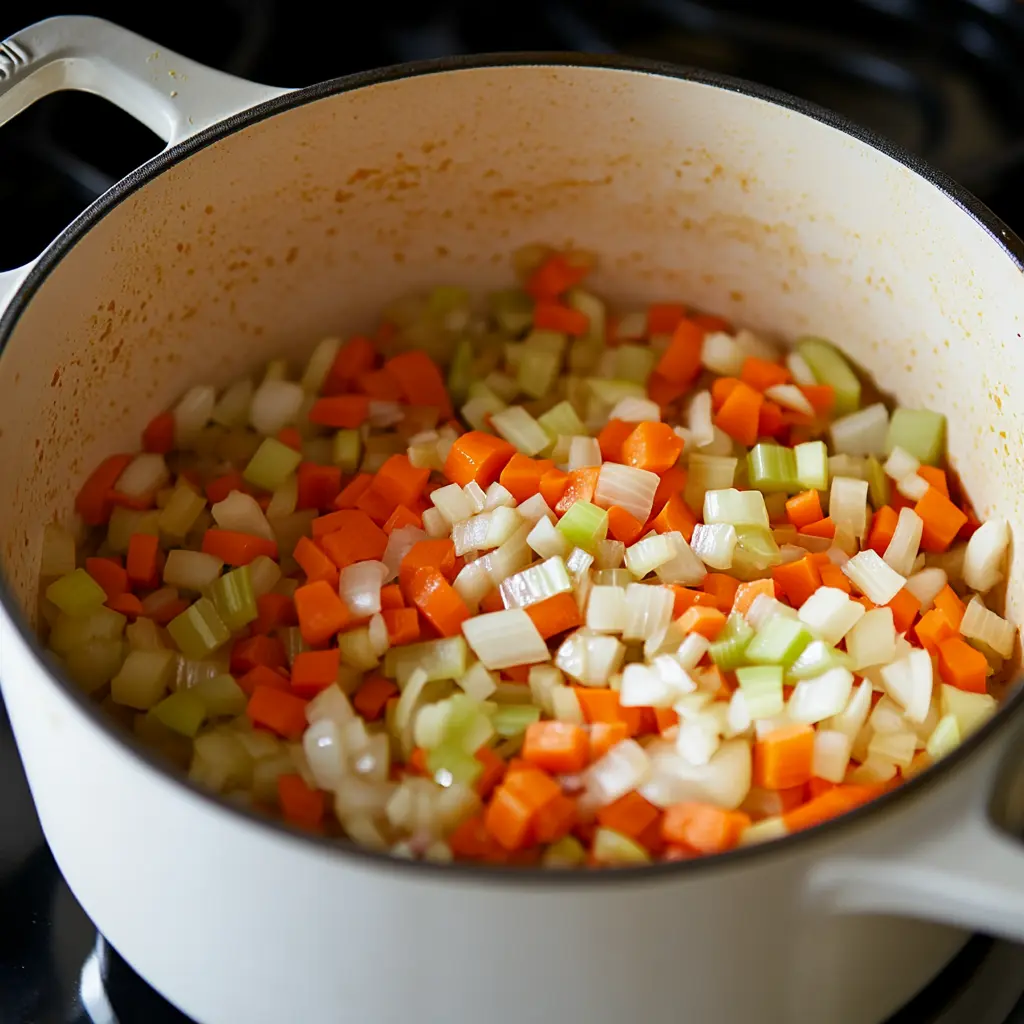
Step 2: Sauté Aromatics
- In a large pot, heat olive oil over medium heat.
- Add diced onion, garlic, carrot, and celery.
- Cook until softened and fragrant, about 6–8 minutes.
This base layer is crucial. It sets the tone for the entire pot of minestrone soup, so don’t rush it.
Step 3: Add Broth, Tomatoes & Herbs
- Stir in crushed tomatoes or tomato puree.
- Pour in your broth (vegetable or chicken).
- Add herbs and a Parmesan rind if using.
Bring the mixture to a gentle simmer. This is where your minestrone soup begins to come alive with richness and aroma.
Step 4: Add Beans and Veggies
- Stir in your beans (cannellini, kidney, or chickpeas).
- Add chopped green beans, zucchini, potatoes, or other seasonal vegetables.
- Let it simmer for 15–20 minutes until everything is fork-tender.
Tip: Add denser veggies earlier, delicate ones (like spinach or peas) toward the end.
Step 5: Cook Pasta, Rice, or Quinoa
- Add your carb of choice and cook just until tender:
- Pasta: 8–10 minutes
- Quinoa: 12–15 minutes
- Rice: 15–20 minutes
For meal prepping or freezing, cook pasta separately and add before serving. This prevents sogginess in leftover minestrone soup.
Step 6: Taste and Finish
- Add salt and black pepper to taste.
- Stir in spinach, kale, or chopped parsley and simmer 2 more minutes.
- Splash in lemon juice or vinegar for brightness.
- Remove Parmesan rind (if used).
That final seasoning adjustment makes all the difference—it brings your minestrone soup to life.
Optional Cooking Methods
| Method | Time | Best For |
|---|---|---|
| Stovetop | 30–40 minutes | Traditional and best for texture control |
| Slow Cooker | 4–6 hours low | Hands-off cooking, great for batch prep |
| Instant Pot | 3–5 minutes + NPR | Fast and reliable for weeknights |
Regardless of method, the steps remain largely the same—just adapt timing as needed. Either way, the result is a pot of nourishing, hearty minestrone soup that’s as flexible as it is flavorful.
Customizing Your Minestrone for Any Season
Seasonal Flexibility Is What Makes Minestrone Soup a Year-Round Favorite
Minestrone soup isn’t just a winter warmer or a light lunch—it’s both, and everything in between. Thanks to its flexible foundation, you can easily tweak the ingredients based on what’s in season or what’s in your fridge. From hearty root vegetables in January to fresh zucchini and basil in July, this classic Italian soup adapts beautifully to every time of year.
That’s what makes minestrone soup a meal-prep MVP for home cooks who want both comfort and variety without reinventing the wheel every week.
Winter Minestrone: Rich, Warming, and Filling
In colder months, go for dense, starchy vegetables and deeper flavors:
- Butternut squash
- Sweet potatoes
- Kale or Swiss chard
- Cabbage
- White beans or lentils
- Tomato paste (for thicker broth)
Add a swirl of pesto or a Parmesan rind to enrich the broth. Serve with crusty bread and a sprinkle of grated cheese for a satisfying cold-weather dinner.
Tip: For added depth, start your winter minestrone soup with a splash of red wine when sautéing the aromatics.
Summer Minestrone: Light, Fresh, and Vibrant
When fresh produce is plentiful, lighten things up with:
- Zucchini
- Green beans
- Cherry tomatoes
- Fresh corn
- Baby spinach or arugula
- Basil, parsley, or dill for finishing
Use a light vegetable broth and skip heavy carbs—try adding quinoa instead of pasta for a lighter, protein-rich version of minestrone soup.
Custom Protein Options for All Diets
| Protein Type | Best For | How to Add |
|---|---|---|
| Chickpeas or Cannellini Beans | Vegan/Vegetarian | Add during simmering |
| Grilled Chicken | High-protein meal prep | Stir in pre-cooked, shredded chicken before serving |
| Ground Turkey | Lean meat lovers | Brown first with aromatics before adding liquid |
| Sausage | Winter variation | Sliced and browned, adds bold flavor |
| Tofu or Tempeh | Plant-based protein | Pan-fry for texture, add toward the end of cooking |
Whether you’re aiming for a light vegetarian dish or a protein-heavy post-workout meal, minestrone soup molds itself around your needs without compromising on flavor.
Tips for Seasonal Swaps
- Swap out kale for baby spinach in summer.
- Use lentils instead of beans for a rustic texture.
- Add fresh herbs only at the end to retain brightness.
- Choose pasta in colder months and quinoa or rice in warmer ones.
- Use homemade broth or bouillon cubes to boost the base flavor.
Common Mistakes (and How to Avoid Them)
Why Your Minestrone Soup May Fall Flat—and How to Fix It
Even though minestrone soup is meant to be forgiving and flexible, a few small missteps can lead to bland broth, soggy pasta, or inconsistent texture. The good news? These common errors are easy to avoid once you know what to watch out for.
Let’s take a closer look at the most frequent issues home cooks run into when preparing minestrone soup, and how to keep your next batch full of flavor and perfectly balanced.
Overloading the Pot
It’s tempting to throw in every vegetable in your crisper drawer, but too many ingredients can create a muddled flavor. When it comes to minestrone soup, restraint equals better balance.
Fix: Stick to 5–7 types of vegetables and 1 or 2 types of beans. This gives each ingredient room to shine without overwhelming the broth.
Adding Pasta Too Early
If you cook pasta directly in the soup from the beginning, it can overcook and break down, turning your broth starchy and thick.
Fix: Add pasta in the last 8–10 minutes of simmering or cook it separately and stir it in right before serving. This helps maintain the soup’s structure and keeps the pasta al dente, even when reheated.
Skipping the Acid
Without a touch of acidity, your soup may taste flat, especially if it’s simmered for a long time. This is a common reason why even well-seasoned minestrone soup can feel like it’s missing something.
Fix: Just before serving, add a splash of lemon juice or a drizzle of balsamic vinegar. This wakes up all the other flavors and gives the broth a clean finish.
Undercooked or Overcooked Veggies
Each vegetable in minestrone soup has a different cook time. Undercooked carrots and overcooked spinach can ruin the texture contrast that makes this soup so enjoyable.
Fix: Add hearty vegetables like carrots, potatoes, and green beans early. Softer ones like zucchini and leafy greens should go in during the last 5–10 minutes of cooking.
Not Seasoning in Layers
If you dump all your seasonings in at once and call it a day, your soup might end up tasting one-note or dull. Minestrone soup needs gradual flavor building.
Fix: Start by seasoning your aromatics with salt, garlic, and herbs. Add another layer of seasoning after adding the broth and again before serving. Taste and adjust as needed throughout the cooking process.
Summary: How to Always Get It Right
| Mistake | How to Avoid It |
|---|---|
| Too many ingredients | Use a limited mix of vegetables and 1–2 beans max |
| Soggy pasta | Cook pasta separately or add at the end |
| Flat flavor | Add acid like lemon or vinegar at the end |
| Texture imbalance | Time your vegetables according to their cook rate |
| Weak seasoning | Season in layers and taste as you go |
Mastering these details ensures that every batch of minestrone soup you make hits all the right notes—comforting, flavorful, and full of perfectly balanced texture.
Serving and Pairing Ideas
How to Serve Minestrone Soup Like a Pro
Minestrone soup is more than a meal—it’s a complete experience. With its rich, comforting flavors and colorful ingredients, this Italian classic deserves a thoughtful presentation and well-paired sides to elevate it from simple to sensational.
Whether you’re hosting guests or meal-prepping for the week, the way you serve minestrone soup can make all the difference. From garnishes and toppings to sides and beverages, here’s how to round out your bowl and impress every time.
Perfect Garnishes for a Flavor Finish
Adding the right finishing touches brings out the best in every spoonful of minestrone soup. Try one or more of the following:
- Freshly grated Parmesan: Classic, savory, and perfect for melted richness.
- Crusty sourdough or garlic bread: Ideal for soaking up that flavorful broth.
- A swirl of pesto: Adds bold herbal notes and richness.
- Chili oil or red pepper flakes: For those who love a gentle heat.
- Toasted pine nuts: Adds crunch and nutty complexity.
- Fresh basil or parsley: A final burst of color and aroma.
Side Dishes That Complement Minestrone Soup
While minestrone soup is filling on its own, the right side dish can enhance its appeal—whether you’re serving it for lunch, dinner, or a cozy weekend brunch.
| Side Dish Option | Why It Works |
|---|---|
| Green salad with vinaigrette | Brightens and balances the earthy soup flavors |
| Grilled cheese sandwich | Adds indulgence and pairs beautifully with tomato broth |
| Crispy rice cakes or crackers | Adds crunch and contrast |
| Stuffed mushrooms | Bite-sized and packed with flavor |
| Caprese skewers | Keeps things light but flavorful |
Creative Ways to Serve for Different Occasions
- Family-style dinner: Serve minestrone soup in a large Dutch oven at the center of the table with small bowls of toppings so guests can customize their own.
- Weekday lunch prep: Portion soup into glass containers, add pasta or quinoa separately, and garnish just before eating.
- Dinner party starter: Serve in small mugs or espresso cups with a pesto crostini on the side.
Storing, Freezing, and Reheating Minestrone Soup
How to Store Minestrone Soup Without Losing Flavor or Texture
Minestrone soup is one of those dishes that gets even better the next day. As the ingredients rest, the flavors deepen and mingle—making your leftovers just as crave-worthy as your first serving. But storing it correctly is key to keeping that delicious balance intact.
Here’s how to properly store your minestrone soup to extend freshness without sacrificing quality:
- Let it cool completely before transferring to storage containers.
- Use glass or BPA-free airtight containers to prevent leaks and odor absorption.
- Store in the fridge for up to 4 days.
Tip: Keep pasta or rice separate from the main soup base to avoid it getting mushy. Add it only when reheating.
Freezing Minestrone Soup for Longer Storage
Want to make a big batch of minestrone soup for later? Good news—it freezes beautifully. Follow these steps for freezer success:
- Freeze only the soup base (without pasta) for best texture.
- Divide into individual or family-size portions using freezer-safe containers or zip-top bags.
- Label with date and ingredients for easy identification.
- Freeze flat if using bags to save space.
Your soup will last up to 3 months in the freezer.
Thawing Tip: For best results, thaw overnight in the fridge or use the defrost setting on your microwave. Avoid microwaving straight from frozen if you want to preserve the vegetable textures.
Reheating Like a Pro
To reheat your minestrone soup without turning it to mush:
- Stovetop: Pour soup into a saucepan and heat over medium, stirring occasionally until hot. Add fresh herbs or cooked pasta if needed.
- Microwave: Heat in 1-minute bursts, stirring in between to avoid uneven heating. Cover loosely to prevent splattering.
- Instant Pot: Use the “Sauté” or “Keep Warm” function to gently reheat larger quantities without overcooking the ingredients.
Bonus Tip: Add a splash of broth or water if the soup has thickened too much after chilling or freezing.
Storage Cheat Sheet
| Storage Method | Shelf Life | Best Practices |
|---|---|---|
| Refrigerator | Up to 4 days | Store without pasta for better texture |
| Freezer | Up to 3 months | Freeze in flat bags or freezer-safe containers |
| Reheating | Stove/Microwave/IP | Add liquid if needed, stir well during reheating |
With proper storage, your minestrone soup can go from freezer to table in minutes—perfect for hectic days when you want something warm, nourishing, and homemade.
Nutritional Benefits of Minestrone Soup
Why Minestrone Soup Is a Smart Choice for Any Diet
Minestrone soup isn’t just a comforting, delicious meal—it’s also packed with nutrients that support energy, digestion, and immune function. Whether you’re vegan, gluten-free, or just looking to eat more whole foods, this soup offers balanced nutrition in every bowl.
With a base of fiber-rich vegetables, plant-based proteins from beans, and slow-digesting carbs from pasta or grains, minestrone soup nourishes your body without weighing you down.
What Makes Minestrone Soup So Healthy?
Here’s a breakdown of what’s inside a traditional bowl of minestrone soup, and why it deserves a regular spot in your meal rotation:
| Nutrient Source | Health Benefit |
|---|---|
| Vegetables | High in fiber, vitamins A, C, K, and antioxidants |
| Beans/Legumes | Great source of plant protein, fiber, and iron |
| Tomatoes | Rich in lycopene, an antioxidant that supports heart health |
| Olive oil | Contains heart-healthy monounsaturated fats |
| Broth base | Hydrating and low-calorie, perfect for light meals |
| Whole grains (quinoa, brown rice) | Boosts satiety and regulates blood sugar |
Supports Gut Health and Weight Management
The fiber from beans, carrots, leafy greens, and other vegetables in minestrone soup feeds your gut microbiome, promoting better digestion and helping prevent blood sugar spikes. It’s filling without being heavy, making it ideal for those watching their caloric intake.
Bonus: Swapping refined pasta for quinoa or brown rice increases the protein and adds complex carbs that help sustain energy throughout the day.
Allergy-Friendly and Highly Customizable
One of the best things about minestrone soup is that it easily fits into various dietary lifestyles:
- Vegan: Skip cheese and use vegetable broth.
- Gluten-Free: Use gluten-free pasta, rice, or quinoa.
- Low-Sodium: Use homemade broth and rinse canned beans thoroughly.
- Low-Fat: Omit oil and use water or broth to sauté vegetables.
You can adapt it to suit virtually anyone at the table—kids, picky eaters, or those with food sensitivities.
A Clean-Eating Staple That Doesn’t Feel Like a Sacrifice
Unlike some “healthy” meals that leave you feeling deprived, minestrone soup is satisfying, flavorful, and full of variety. It’s proof that clean eating doesn’t mean bland eating.
FAQs About Minestrone Soup
What is the secret ingredient in minestrone soup?
The secret ingredient in minestrone soup is often a Parmesan rind simmered in the broth. It slowly melts into the soup, adding deep umami flavor without overpowering the vegetables. For a vegan twist, nutritional yeast or a spoonful of pesto can add similar richness and complexity.
What are all the ingredients in minestrone soup?
A traditional minestrone soup includes aromatics like onions, garlic, and celery; vegetables such as carrots, zucchini, spinach, and green beans; legumes like cannellini or kidney beans; a tomato-based broth; and a carbohydrate such as pasta, rice, or quinoa. Herbs, olive oil, and seasoning like oregano and thyme round out the flavor.
How to make the perfect minestrone?
To make the perfect minestrone soup, start by sautéing your aromatics until fragrant, then add tomatoes, broth, vegetables, and beans in the right sequence. Simmer until tender, and finish with greens, fresh herbs, and a splash of acid like lemon juice. Cook pasta separately if you plan to store leftovers, and always taste and adjust the seasoning before serving.
What is in traditional minestrone soup?
Traditional minestrone soup includes a variety of seasonal vegetables, white or red beans, pasta or rice, and a tomato-based broth seasoned with garlic, onion, olive oil, and Italian herbs. It’s a dish rooted in Italian peasant cooking, designed to be both flexible and filling with whatever fresh produce is available.
Conclusion
Minestrone soup isn’t just a dish—it’s a nourishing tradition that adapts to your lifestyle, ingredients, and seasons. Whether you’re craving a comforting winter meal or a light, veggie-packed lunch, this Italian classic delivers hearty nutrition and big flavor with every bowl.
From its humble roots to its modern variations, minestrone soup continues to win over kitchens around the world because it’s affordable, versatile, and easy to make. With the tips and techniques you’ve learned in this guide—from building flavor and avoiding common mistakes to mastering seasonal swaps—you now have everything you need to make a perfect pot every time.
Remember, the beauty of minestrone soup lies in its flexibility. Use what you have. Trust your taste buds. And don’t be afraid to experiment with new variations.
Now grab that Dutch oven, prep your veggies, and start simmering—you’re just one pot away from one of the most timeless comfort foods on the planet.

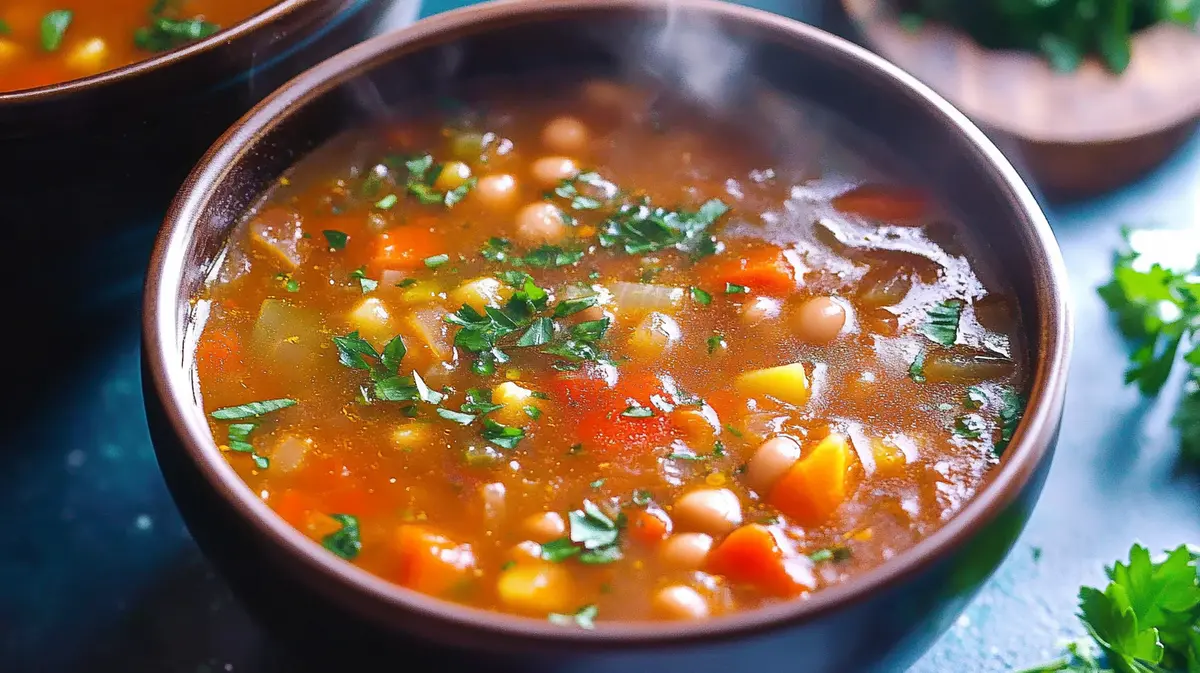
1 thought on “Hearty Vegan Minestrone Soup with Quinoa – A Nourishing Italian Classic Reinvented”